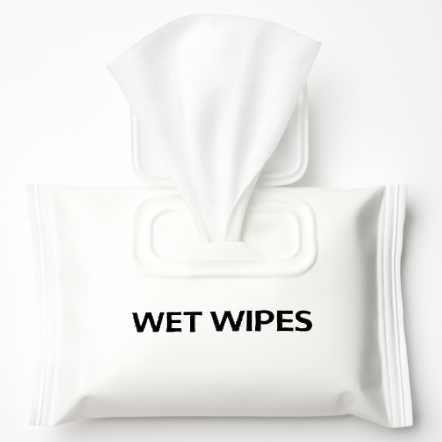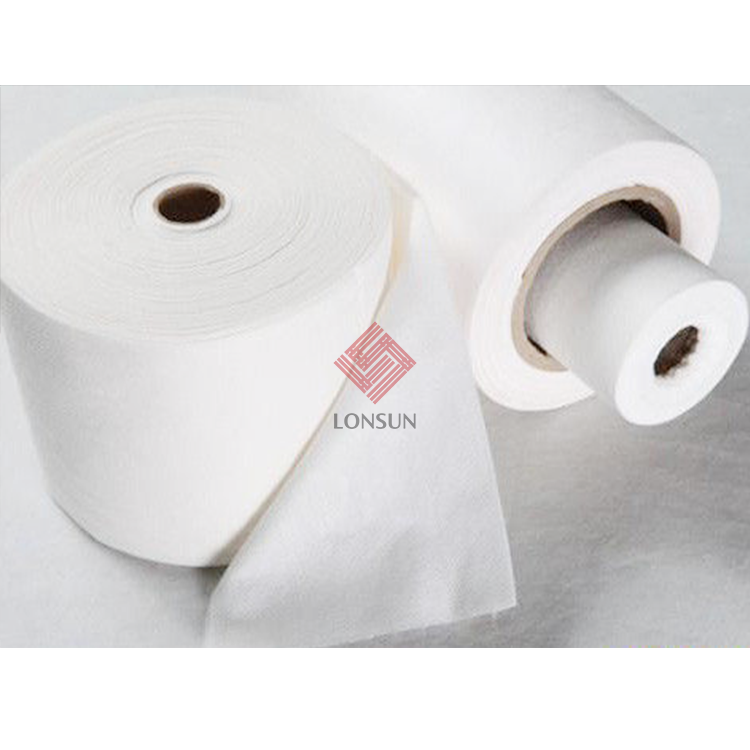Home
Home | About Us | Advantages | Blogs | Contact Us
- All
- Product Name
- Product Keyword
- Product Model
- Product Summary
- Product Description
- Multi Field Search
Home | About Us | Advantages | Blogs | Contact Us









Wet wipes are an essential product used in households and industries worldwide. But have you ever wondered what they’re really made of? Understanding their composition is crucial for knowing how effective and safe they are.In this post, we’ll explore what wet wipes are made of, their benefits, and how they’re manufactured.
Wet wipes are made up of two main components: nonwoven fabric and a cleansing solution. These elements work together to create a convenient and effective cleaning tool.
Nonwoven fabric forms the base of most wet wipes. Unlike traditional woven fabrics, nonwoven materials are created by bonding fibers together, often through heat or pressure. This gives the fabric strength and flexibility, making it resistant to tearing during use.
The wetting solution is what makes the fabric moist and effective at cleaning. It consists mainly of water and additional ingredients. The right balance of these ingredients ensures that the wet wipe is both effective at cleaning and safe to use on the skin.Together, these two components make wet wipes versatile and powerful. The fabric holds the solution and allows it to be spread evenly, while the solution enhances the cleaning and moisturizing properties. Without the right combination, a wet wipe wouldn’t be as efficient or comfortable to use.
Wet wipes rely on various materials, known as substrates, to provide strength, absorbency, and comfort. These materials play a vital role in ensuring the effectiveness of wet wipes for different uses.
Wood pulp is one of the most common materials used in wet wipes. It has a flat, ribbon-like fiber structure that increases surface area, making it highly absorbent. This feature is especially useful for wiping up liquids and providing effective cleaning. Its natural ability to absorb moisture helps it maintain integrity during use. Wood pulp is widely used because it’s cost-effective and works well for various cleaning tasks.
Cotton is another popular choice due to its natural absorbency and durability. It’s known for being gentle on the skin, making it perfect for sensitive areas like a baby’s skin. Cotton can hold a large amount of moisture without falling apart, making it ideal for personal care wipes. It's soft, strong, and breathable, which helps reduce skin irritation.
Viscose is a semi-synthetic fiber that offers a smooth, silky texture, often used in baby wipes and facial tissues. Compared to cotton, it feels softer and gentler on the skin. Viscose is great for sensitive skin but isn’t as durable as cotton. It provides a luxurious feel, which is why it’s often used in products designed for personal care.
Polyester is a strong and durable synthetic material often used in wet wipes. It resists tearing, even during heavy use. Polyester also maintains its shape, preventing the wipes from shrinking or losing strength when exposed to moisture. This material is excellent for tough cleaning tasks, ensuring the wipes hold up during cleaning without disintegrating.
Bamboo is gaining popularity as an eco-friendly material for wet wipes. It’s naturally antibacterial and hypoallergenic, making it a safe and gentle choice for sensitive skin. Bamboo is biodegradable, reducing the environmental impact of wet wipe disposal. This sustainable material provides a strong, soft texture, and its antimicrobial properties make it a suitable option for wipes that need to maintain cleanliness without harmful chemicals.

When it comes to wet wipes, the fabric used plays a key role in their performance. Nonwoven fabrics are a popular choice, and they’re quite different from traditional woven fabrics.
Nonwoven fabrics are made by bonding fibers together, often through heat, pressure, or chemical processes, rather than weaving them together like traditional fabrics. This means they don’t require the time-consuming process of weaving fibers into an interlocking pattern. The result? Strong, durable fabric with great absorbency.Nonwoven fabrics are designed to perform in specific ways. For example, they can be engineered to be soft, absorbent, or resistant to tearing, depending on the product's needs. This flexibility makes them ideal for use in wet wipes, where durability and absorbency are crucial.
Nonwoven fabrics are perfect for wet wipes because they provide the right balance of strength and softness. Unlike woven fabrics, which can be too stiff or fragile when wet, nonwoven materials maintain their integrity. They’re engineered to absorb moisture efficiently without falling apart.
Durability: Nonwoven fabrics can hold up well even when wet, preventing tearing during use.
Absorbency: These fabrics can absorb and hold liquids better, making them more effective at cleaning and wiping surfaces.
Strength: Nonwoven fabrics resist stretching and tearing, even during heavy-duty cleaning.
For wet wipes, this means the material stays intact and effective, no matter how much moisture it holds or how vigorously it’s used.
The wetting solution in wet wipes is made up of several key ingredients that contribute to its effectiveness and user-friendliness. Let’s break down the role of each.
Water is the most important ingredient in wet wipes. It makes up the majority of the wetting solution and serves as the carrier for all other ingredients. Purified water is essential because it’s free from impurities, ensuring that the wipe remains safe to use on skin.
Detergents, particularly amphoteric surfactants, are added to the solution for their cleaning properties. These surfactants are mild and effective at removing dirt and oils without harming the skin. Amphoteric surfactants are often chosen because they are gentle and won’t strip away natural oils from the skin, making them ideal for personal care wipes.
Moisturizing agents, or humectants, prevent the wet wipes from drying out too quickly. They also help keep the skin hydrated. Common moisturizing agents include glycerin and aloe vera. These ingredients are soothing and beneficial for sensitive skin, making them a popular choice in wipes designed for babies or facial cleansing.
Thickeners help adjust the consistency of the wetting solution, ensuring that it’s the right thickness for spreading across the fabric without dripping. Preservatives are added to prevent microbial growth, extending the shelf life of the wipes and ensuring they stay safe to use. These ingredients help maintain the quality and hygiene of the product over time.
Some wet wipes include oils like coconut or vitamin E, which help moisturize and nourish the skin. Fragrances are often added to enhance the user experience, providing a pleasant scent. However, some wipes are fragrance-free to accommodate users with sensitive skin or allergies.
Not all wet wipes are the same. Their formulations can vary based on their intended use, such as for babies, antibacterial purposes, or being flushable.
Baby wipes are specially formulated to be gentle on a baby’s sensitive skin. The ingredients in baby wipes are carefully chosen for their mildness and hypoallergenic properties. They typically avoid harsh chemicals and fragrances, which could irritate the skin. Common ingredients include soothing agents like aloe vera and vitamin E. These wipes are designed to clean effectively without drying or harming delicate skin.
Antibacterial wipes are formulated to kill germs and bacteria. They often contain disinfectant agents like benzalkonium chloride, which is effective in sanitizing surfaces or hands. These wipes are popular in public places or for on-the-go cleaning. From a regulatory standpoint, antibacterial wipes must meet specific guidelines to make “antibacterial” claims. This means that the active ingredients must be present in sufficient quantities to prove their germ-killing effectiveness.
Flushable wipes are designed to be safely disposed of by flushing them down the toilet. To achieve this, their formulation differs from regular wet wipes. These wipes are made from biodegradable materials that break down easily in water. This is crucial to prevent plumbing blockages. Often, flushable wipes are made with natural fibers like cellulose or bamboo, which ensure they disintegrate quickly in the system. These wipes are not only convenient but also help reduce waste.
The manufacturing of wet wipes is a carefully controlled process, with each step designed to ensure the final product is effective, safe, and high-quality. Let’s break down the process.
The first step in creating wet wipes is mixing the cleansing ingredients. This involves adding water and other substances like detergents, moisturizers, and preservatives into large tanks. The ingredients must be blended together until the mixture reaches the right consistency. Quality checks are done during this stage to ensure the mixture is even and free from contaminants. If necessary, the mixture is heated to ensure the ingredients dissolve properly and combine effectively.
Next, the nonwoven fabric is prepared. There are two main methods for assembling the fabric: the wet-laid process and the dry-laid process.
Wet-Laid Process: In this method, fibers are mixed into a semi-liquid solution containing water and chemicals. The mixture is then pressed into flat sheets using rollers. This process is typically used for softer wipes, like baby wipes.
Dry-Laid Process: For this method, plastic pellets are melted and forced through tiny holes using air pressure. The fibers cool down and bond together, forming a sheet. This process is used for stronger wipes, such as those for industrial cleaning.
Each method impacts the softness and strength of the fabric, with wet-laid fabrics being gentler and dry-laid fabrics being more durable.
Once the fabric is ready, it’s treated with the cleansing solution. The solution is either sprayed onto the fabric or the fabric is immersed in it. The goal is to ensure that every wipe is evenly saturated, which is essential for effective cleaning. The solution must be evenly distributed across the entire fabric to prevent uneven moisture levels. This step also includes quality control to ensure that the wipes are properly saturated without being too wet.
After the fabric is treated, it’s cut into individual wet wipes. The large rolls of fabric are slit into smaller pieces, which are then folded into the desired size. The folded wipes are stacked and moved to the packaging stage. Various packaging options are used, including soft packs, canisters, and individual sachets, depending on the product. Packaging ensures that the wipes remain moist and hygienic, often using resealable seals or airtight containers. This packaging helps maintain the quality of the wipes, preventing them from drying out or becoming contaminated.
In summary, wet wipes are made from materials like nonwoven fabrics and cleansing solutions. The choice of fabric—such as cotton, wood pulp, or bamboo—affects their durability and absorbency. When selecting wet wipes, consider your needs, such as skin type, cleaning tasks, and environmental impact. As technology advances, we can expect even more innovative and eco-friendly wet wipe products in the future.